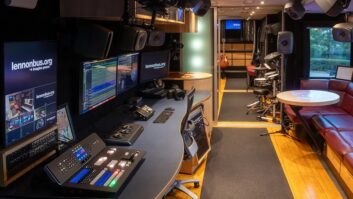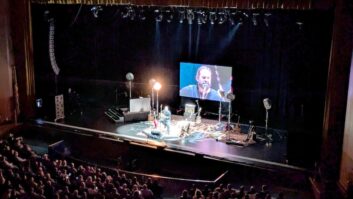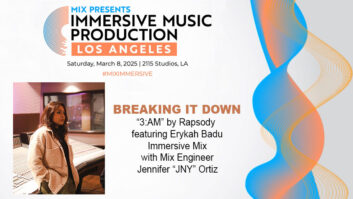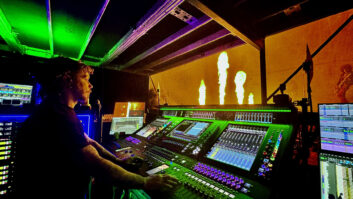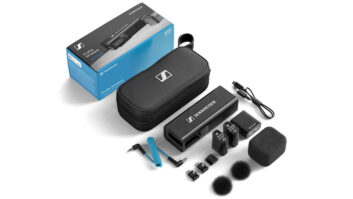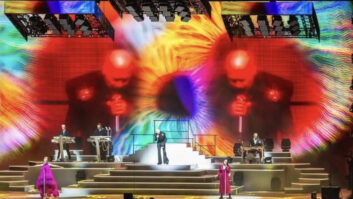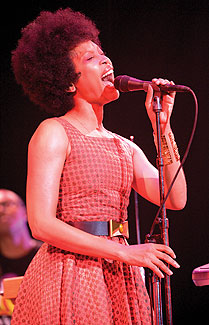
Erykah Badu performing live.
To prepare for previous tours, Erykah Badu would get the band and sound engineers Kenneth H. Williams and Kenny Nash together in Dallas for a couple of weeks of rehearsals. But when Badu called on Williams and Nash for a run of shows this September, there was no mention of rehearsal — all they knew was that they were due in San Francisco on September 3, 2009.
Welcome to The Cannabinoids tour, a collective of Badu and seven producer/DJs: longtime musical director RC Williams, Jah Born, Rob Free, Symbolic One, Picnic, and DJs A ONE and Big Texas. The “band” was put together to combine the vibe of live music improv with the technology found in the recording studio. Badu’s new musical peers pulled songs off of nearly every one of her releases, bringing new life to “On & On,” “Apple Tree,” “Danger” and “Soldier,” the latter from her latest release, New Amerykah, Pt. 1: 4th World War.
However, Williams and Nash didn’t know this when they arrived at the San Francisco International Airport just eight hours before showtime. “The first time I met the guys was at the airport in S.F.,” recalls front-of-house mixer Williams. “The first time I heard the band was at soundcheck. We didn’t know the input situation with the computers and turntables, who was singing vocals, what parts they were singing or even the song list until we got there.”
That might send other mixers scrambling but Williams had learned a valuable lesson when he joined Badu’s camp six months earlier. “The first thing that Kenny and [lighting designer] Martin Thomas told me was that they subscribed to the Navy Seals motto of ‘run and gun.’ They said, ‘Hey, we kind of know what’s going on, but we just go for it. You’ll get it after the first show.’”
“You’ve got to learn to do things on the move,” Nash adds. “She’s an artist. You learn exactly what that means, and you learn what she’s looking for and how things flow in her world. Artists move really fast: They see life differently and they need people like us around to stabilize things. How do we make sure the picture she wants happens? That’s on us on the technical side.”

FOH engineer Kenneth H. Williams and systems tech Gabe Nahshon of Sound on Stage
For the pair of shows in the San Francisco Bay Area — September 3 at Davies Symphony Hall in San Francisco and September 4 at the Paramount Theatre in Oakland across the Bay — the tour rented gear from Sound on Stage. The only thing Nash brought was Badu’s Shure KSM9 microphone and her Theremin. For the P.A. system, SOS supplied 20 boxes of L-Acoustics V-DOSC, eight SB218 subs, six ARCS and four JBL MS 28 front-fill speakers. The sound company also supplied a pair of Yamaha PM5DRH desks for FOH and monitors.
The 5Ds became crucial tools for both Williams and Nash as the two didn’t figure out until that first soundcheck was who was going to play which instrument. “When you have a bass guitar and a guitar, you know that one is going to provide the bottom and the other is going to do more of the melodic lines,” Williams explains. “With the computers, samples and drum machines up there, any of the eight people could be the bottom or the drums or a melodic instrument at any point. And it would change from song to song. In fact, during the set I had to constantly use my headphones to verify who was playing what and figure out the structure of the song.”

Monitor engineer Kenny Nash
To solve part of that challenge, Williams set up his console in cells that matched the performers’ positions onstage, starting with Badu, who was on number 1. The rest of The Cannabinoids formed a circle around her, beginning with RC Williams at Badu’s immediate right, then Picnic, DJ Big Texas, A ONE, Symbolic One, Jah Born and Rob Free. “That way, whenever I saw somebody doing something, and I couldn’t discern from the mix exactly what it was, I could go right to the cell and know what that person was playing,” Williams explains. “It was easier to bring it up that way than having to jump around a bunch of layers on the console. It gave me a little more control and I knew where to look for everything.”
The setup also helped him ensure that the mix kept up with Badu. “Erykah has such a broad palate to choose from that she’ll go off and do something that seems structured to the audience,” Williams says, “and I suppose it is because her instructions are simple: ‘Go with me.’ On the first couple shows with The Cannabinoids, I had to write down certain keywords that she would say to let us know where she was going. That allowed me to set up delays and know what I needed to do EQ-wise. She’s so quick and in the moment, I don’t even have pages set up. I have one template and I make the corrections as I go.”
As far as outboard gear, Williams will usually use a Summit Audio TLA-100a on Badu’s vocals. On this night, however, there was no outboard gear to be found.
Monitor Feeds on the Fly
Where Williams is a relatively new citizen in Badu World, Nash has been with the singer for 10 years. Nash’s first introduction came when he subbed for the FOH mixer Gordon Mack III (which is also how Williams got this gig), who was heading out to work with Prince. “We all know how the situation with Prince goes,” Nash says with a laugh. “So Gordon came back; no hard feelings. A little later, he called me, and said, ‘Erykah liked your work and your personality. You want to come out and be her monitor guy?’”
While Nash started out with Badu when she was using personal monitors, the piercings in both ears means that she’s back on wedges. During a typical band show, Badu will get kick, snare, Rhodes, backing vocals, drum machine and her own vocals in the downstage monitors. Side-fills get a full band mix, which Nash explains is where she gets her stage vibe.
Just like Williams, Nash had no idea what was going to happen during The Cannabinoids’ set, so making sure that the band had good monitor mixes was a bit of a challenge. Turns out that most of the producers wanted everything, except for Rob Free, who wanted his own tracks and a little of Badu’s vocals, and Picnic, who wanted himself, Badu and RC Williams.
Nash’s history with Badu and her candor made her monitor mix a bit easier. “I’ve been with her so long that I know what she’s looking for,” he says. “If it seems like there’s a problem, I’ll go stand by the side-fills and she’ll give me the yea or nay. If it’s really bad, in the middle of a song, she’ll say, ‘Kenny.’ I have to stay on my toes.”
Nash works off a PM5D and mixes to L-Acoustics 115XT Hi-Qs, as well as two ARCS and two SB218s per side. Jah Borne, who was running a pair of drum machines (MPC 2000XL and Akai MPD32), got a single 15-inch the first night and then complained to Nash about his monitor rig. “The second night I gave him two double 18s,” Nash says with a laugh. “He played a lot of the 808 stuff and lot of the lower kick drum stuff, so I had to beef up his mix a little bit.”
With three shows under their belt (The Cannabinoids played The Palladium in Los Angeles on September 5), both Williams and Nash are feeling a bit more confident. “We will definitely know everybody is playing,” Williams admits with a laugh. “There weren’t any train wrecks during these first three shows, but there were some interesting times. I really think there’s something special here that’s only going to get better the more we all play together.”
David John Farinella is a San Francisco-based writer.

